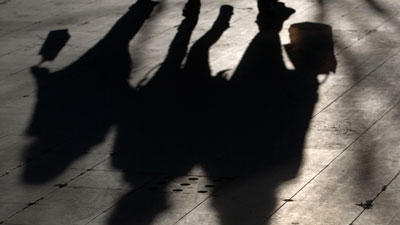According to the UNODC’s (United Nations Office on Drugs and Crime) own statistics, the country registers the highest homicide rate in the world.
But violence in Honduras is also experienced in people’s daily activities, in the streets controlled by maras, in schools where ‘war bonds’ are collected and even in the private lives of the young women gang members choose as partners.
Nevertheless, just as you have soldiers of violence, you also have warriors for peace.
‘Francisca’, ‘Celeste’ and ‘Elena’ are three of them (they use aliases to protect their identities). Like many others, they have personally suffered the violence that each year causes the flight of thousands of fellow citizens seeking a better life. Despite knowing that their lives are in danger, these warriors for peace have decided to fight for their future, especially a future with #JovenesSinViolencia [Youth without Violence].
Fourteen years ago, Francisca left for the United States, leaving her two children, aged 8 and 9, with her mother. With what she earned there, she supported her family and paid for her children’s tuition. In this way, she became one of the more than one million Hondurans immigrants in the US.
But in 2007 the violence that Francisca thought she was safe from touched her very personally. After witnessing the murder of a classmate, her son was threatened. “He went home, took all the money I had sent for food and left for Mexico.” He then crossed the border into the US.
One year later, her daughter was forced by a gang member to become his partner. “The day after she called me I signed my voluntary deportation at the airport and landed in Honduras,” she tells us.
Six years later, her children live in the United States, but she is one of thousands of deported Honduran migrants; according to data from the Returned Migrant Attention Center published by El Heraldo newspaper, they number 31 thousand people this year alone.
Not wanting to give up, Francisca turned to her community. “I finished primary school in 2012, I admit it, and I now work with children,” she explains. Her personal experience made her realize that something must be done for Honduran children, before they are forced to deal with the dilemma of emigrating or being murdered.
Gang Members at School
The harsh truth about the violence being experienced in Honduras has convinced many women such as Francisca to tackle the issue and try to do something for the youngest.
Celeste, for example, is a teacher at an institute in La Ceiba, the third most important city in Honduras, located on the Caribbean’s coastal plain. In her neighborhood “robberies and violence are very common.” So common that they sometimes enter the classroom. “I have had 7th grade students collect a war tax (money to finance maras), she says.
A teacher by calling, Celeste took up the challenge of providing her students with more opportunities. “There are many children that are not good at studying but are capable of painting or cutting trees. We need to be able to offer them this, otherwise they will be stigmatized,” she explains.
Precisely in order to promote the idea that opportunities exist, Celeste organized so-called student patrols, as well as professional workshops and art activities.
Teaching in a violent environment is also not easy for Elena, who hails from El Progreso in Honduras’ northwest. Her school adjoins three streets besieged by maras, and another street ruled by hired killers.
Educating under these circumstances has become a challenge. “Enforcing discipline is very difficult because they respond badly and their parents are soon in school asking that their children get promoted and not reprimanded,” Elena explains.
In order to fight against this, they created guidance and counseling committees which allowed them to follow-up on conflict children and support some parents. “We give talks on how to improve education at home, we organize campaigns and recreational activities,” she says.
The fight of these three women intends to bring hope to a country with a homicide rate of 90.4 per 100,000 inhabitants, according to data from the United Nations Office on Drugs and Crime (UNODC), from 2012. In total there are more than 6 thousand homicides per year, according to that organization.
A Model worth Imitating
Because of the dedication to their community, Celeste and Elena were chosen as community leaders and members of the Safer Municipalities project at the Honduran Government’s Under-Secretariat of Security in Violence Prevention, which is supported by the World Bank. The initiative offers activities such as parental training, organization of extracurricular activities and job training for youngsters.
“This project can be seen as a model worth imitating throughout Honduras, not just in these three cities,” points out Marcelo Fabre, WB Project Manager.
“The initiative will be strengthened as the community begins to get involved,” says Mario Rene Pineda, minister of the Water and Sanitation Community Development Institute (Idecoas, in Spanish), the body in charge of the project. “The most important thing for them is to realize that they are the engines for change,” explains Josue Mejia from the Under-Secretariat of Security in Prevention, Government of Honduras
These three warriors for peace, Francisca, Celeste and Elena, are aware that it is precisely community involvement, the participation and conviction that violence can end, that will make Honduras offer a better future to its children.

